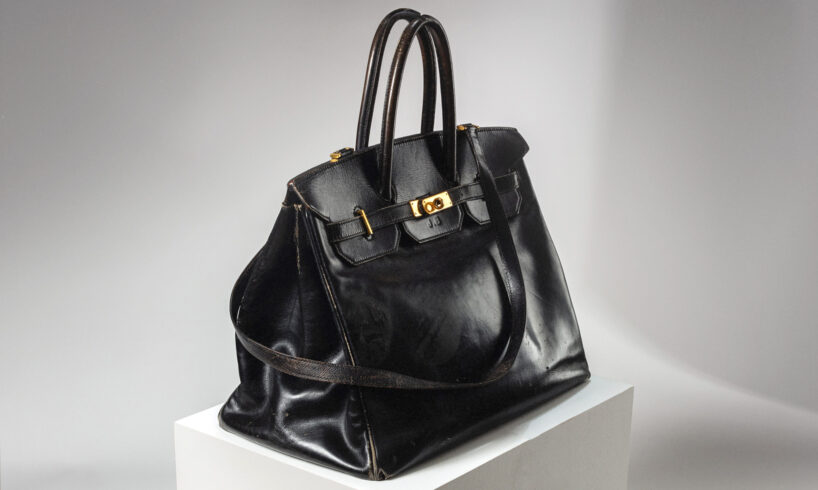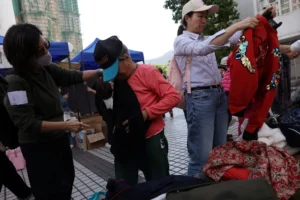
The original black leather Birkin bag, owned and loved by Hermès muse Jane Birkin, has sold for ¥1.47 billion (€8.58 million) to Valuence Japan, the company behind luxury buyer Allu. The historic acquisition took place at a Sotheby’s Fashion Icons auction in Paris on July 10, setting a new world record for the most valuable handbag ever sold.
Sotheby’s opened bidding for the Birkin prototype at €1 million, and a fierce battle ensued between nine collectors. Valuence Japan participated via telephone through Maiko Ichikawa, Head of Sotheby’s Japan, and won the item after the 10-minute bidding war.
“The spectacular sale of the Original Hermès Birkin today at Sotheby’s Paris marks an important milestone in the history of fashion and the luxury industry more widely,” stated Morgane Halimi, Sotheby’s global head of handbags and fashion. “It is a startling demonstration of the power of a legend, and its capacity to ignite the passion and desire of collectors seeking exceptional items with unique provenance.”
A Legendary Fashion Accessory Reemerges
The much-anticipated auction marks the original Birkin’s first market appearance in 25 years. The handbag has been sold twice, initially in 1994 when Jane Birkin donated it to an auction benefiting the French AIDS charity Association Solidarité Sida, and again at auction at Poulain Le Fur in May 2000. Private collector Catherine B., who kept the Birkin for over two decades, told Sotheby’s that the sale “made me relive my own bidding battle … and how raw and indescribable the feeling of winning over this wonderful bag was.”
The mystical Birkin had not been seen by the public until autumn of last year, when it was exhibited at Sotheby’s Paris Galleries. A series of viewings this year at the Sotheby’s Maison in Hong Kong, New York and Paris again attracted thousands of visitors, generating global interest for yesterday’s auction.
Jane Birkin with her stickered Hermès bag in London, 1996 | Image: Mike Daines/Shutterstock
Originally designed by Hermès chief executive Jean-Louis Dumas after a chance encounter with British-French actress and singer Jane Birkin in 1981, the Birkin bag is one of the most famous accessories in fashion history. The story goes that Jane Birkin — who was sitting next to Dumas on a flight — spilled the contents of her wicker basket bag onto his lap, inspiring the then-artistic director to conceptualize a practical handbag large enough to hold her essentials.
The Birkin, intended to fuse the bohemian-chic actress’ effortless elegance with durability and functionality, has evolved into a highly-coveted status symbol around the world. Over the past decade, the handbag has also been at the center of much cultural discourse around overconsumption, wealth disparity and declining individuality, in ironic contrast to its original role as a canvas for Jane Birkin’s self expression. Her well-worn purse was famously decorated with jewelry fragments, scarves and charms.
The original Birkin still bears the traces of Jane Birkin’s personalizations, including her initials “J.B.” and her nail clipper, hanging from the bag’s strap. The prototype is crafted in Hermès Black Box leather with gilded brass hardware, and features a unique construction, blending the Birkin 35’s width and height with the Birkin 40’s depth. It includes details not found on modern models like closed metal rings, an Eclair zipper, a non-removable strap and small bottom studs.
So… Who Bought the Original Birkin Bag?
The buyer who acquired the original Birkin is Tokyo-based company Valuence Japan, which operates several luxury fashion businesses, including big-name buyers Allu and Nanboya. Valuence Japan has emphasized that the acquisition is not for resale purposes. Instead, the company views it as a valuable addition to society — a piece of cultural heritage that will be made accessible to a broad audience.
Shinsuke Sakimoto, CEO of Valuence Japan, shared his thoughts on the acquisition. “Ms. Jane Birkin’s embodiment of freedom and originality deeply resonates with our group’s philosophy,” he told Fashionsnap. “We hope the bag can be a symbol of empowerment, diversity and confidence.”





